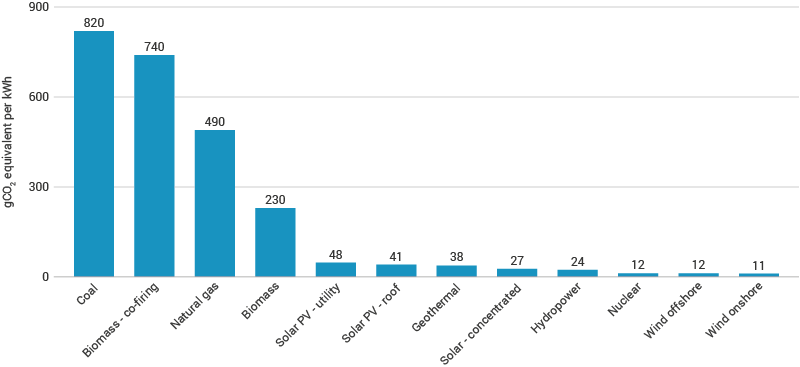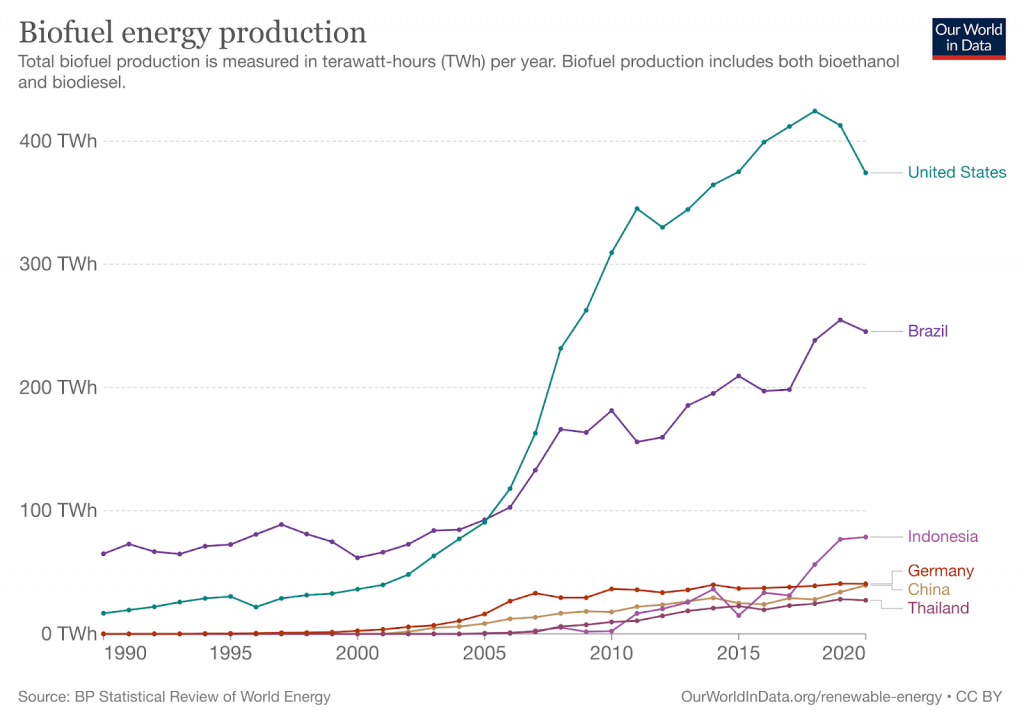What Is the Carbon Footprint of Biomass Energy? A Life-Cycle Assessment
Impactful Ninja is reader-supported. When you buy through links on our site, we may earn an affiliate commission.
Learn more
Learn more
.
Hey fellow impactful ninja ? You may have noticed that Impactful Ninja is all about providing helpful information to make a positive impact on the world and society. And that we love to link back to where we found all the information for each of our posts. Most of these links are informational-based for you to check out their primary sources with one click. But some of these links are so-called "affiliate links" to products that we recommend. First and foremost, because we believe that they add value to you. For example, when we wrote a post about the environmental impact of long showers, we came across an EPA recommendation to use WaterSense showerheads. So we linked to where you can find them. Or, for many of our posts, we also link to our favorite books on that topic so that you can get a much more holistic overview than one single blog post could provide. And when there is an affiliate program for these products, we sign up for it. For example, as Amazon Associates, we earn from qualifying purchases. First, and most importantly, we still only recommend products that we believe add value for you. When you buy something through one of our affiliate links, we may earn a small commission - but at no additional costs to you. And when you buy something through a link that is not an affiliate link, we won’t receive any commission but we’ll still be happy to have helped you. When we find products that we believe add value to you and the seller has an affiliate program, we sign up for it. When you buy something through one of our affiliate links, we may earn a small commission (at no extra costs to you). And at this point in time, all money is reinvested in sharing the most helpful content with you. This includes all operating costs for running this site and the content creation itself. You may have noticed by the way Impactful Ninja is operated that money is not the driving factor behind it. It is a passion project of mine and I love to share helpful information with you to make a positive impact on the world and society. However, it's a project in that I invest a lot of time and also quite some money. Eventually, my dream is to one day turn this passion project into my full-time job and provide even more helpful information. But that's still a long time to go. Stay impactful,Affiliate Disclosure
Why do we add these product links?
What do these affiliate links mean for you?
What do these affiliate links mean for us?
What does this mean for me personally?
![]()
Biomass is a renewable energy source that some assert can be used to reduce global carbon dioxide emissions. However, in reality, it may do more harm than good. So we had to ask: What is the carbon footprint of biomass energy?
Biomass energy has the fourth-highest carbon footprint of all energy types. Per kWh produced, biomass fuel emits 230 grams of carbon dioxide (CO2) on a life-cycle basis. It directly contributes to climate change, has various negative environmental effects, and is not as beneficial as it might seem.
Keep reading to learn about the overall carbon footprint of biomass energy and its carbon footprint throughout its life-cycle.
How is Biomass Energy Defined
Biomass is renewable organic material that comes from plants and animals. It is incredibly versatile and can be used to produce fuel, energy, and everyday products that contain plastics.
“Biomass: natural materials from living or recently dead plants, trees and animals, used as fuel and in industrial production, especially in the generation of electricity”
Oxford Dictionary
Sources of biomass energy include:
- Wood and wood processing wastes
- Agricultural crops and waste materials
- Municipal solid waste
- Animal manure
- Human sewage
To harvest biomass energy, wood, agricultural crops, biogenic materials, animal manure, and human sewage are burned or are converted to release stored chemical energy from the sun.
Biomass can be used to produce the following:
- Biofuels: Biomass is converted into liquid fuel (ethanol and biodiesel) used for transportation. Biofuels include fuels made from crops such as corn, sugarcane, hemp, and cassava.
- Biopower: Biomass fuel is converted into energy via combustion, bacterial decay, or conversion to gas/liquid fuel.
- Bioproducts: Biomass is chemically converted into plastics and other products made from petroleum.
Biomass continues to be a major fuel in developing countries, especially for heating and cooking. This is known as traditional biomass. Countries that rely heavily on traditional biomass include Niger, Kenya, Tanzania, Nigeria, the Democratic Republic of Congo, and Haiti.
In developed countries, it has been used increasingly as transportation fuel and to reduce CO2 emissions from fossil fuels like coal and oil. These countries include the US, Brazil, Indonesia, Germany, and China.
In 2020, 4.5 quadrillion British thermal units (Btu) of biomass were consumed in the US alone. 2.5 quadrillion Btu of these were from wood and waste, and 2.0 quadrillion Btu were from biofuels. Collectively, energy from biomass represents around 39% of total renewable energy consumption in the US.
What is the Carbon Footprint of Biomass Energy
The carbon footprint is one of the ways we measure the effects of human-induced global climate change. It primarily focuses on the greenhouse gas (GHG) emissions associated with consumption, but also includes other emissions such as CH4, nitrous oxide, and chlorofluorocarbons.
“Carbon footprint: the amount of greenhouse gases and specifically carbon dioxide emitted by something (such as a person’s activities or a product’s manufacture and transport) during a given period”
Merriam Webster
Basically, it is the amount of carbon emitted by an activity or an organization. This includes GHG emissions from fuel that we burn directly (e.g., heating a home, driving a car) and GHG emissions from manufacturing the products that we use (e.g., power plants, factories, and landfills).
What Is the Overall Carbon Footprint of Biomass Energy
Regular biomass energy emits 230 grams of CO2 equivalent per kWh (gCO2 per KWh), the fourth-highest amount out of all of the fuel types, and the highest amount out of all of the renewable fuel types. Co-firing biomass energy, where biomass is added as a partial substitute fuel in coal boilers, emits 740 gCO2 per KWh, the second-highest amount out of all fuel types and second only to coal.

In 2018, 637 Terawatt hours (TWh) of electricity were produced globally from biomass. Solid biomass accounted for 66% (420 TWh), municipal and industrial waste 19% (121 TWh), and biogas 14% (89 TWh) of total biopower.
Also in 2018, 160 billion liters (bl) of biofuels were produced globally from biomass. North and South America account for 75% and Europe 14% of global biofuel production.

The six largest biofuel-producing countries (amount per year) in the world are:
- United States – 374 billion KWh (bKWh)
- Brazil – 245 bKWh
- Indonesia – 78 bKWh
- Germany – 40 bKWh
- China – 39 bKWh
- Thailand – 27 bKWh
Because biomass is still an important fuel source for the developing world and has become an important transportation fuel in the developed world, it is important to understand what its carbon footprint is and how its carbon emissions affect the global climate change process.
To understand the carbon footprint of biomass energy, we must assess its life-cycle and each stage’s carbon footprint. This life-cycle assessment (LCA) is a method to evaluate the environmental impacts of products and materials. Over the years, companies have strategically used LCA to research and create more sustainable products. So, let’s have a look at the LCA of biomass energy!
| The life-cycle stages of biomass energy | Each stage’s carbon footprint |
| Building of biomass energy | CO2 emissions from extracting and processing biomass, transportation of biomass on trucks or by rail, construction of biomass power plants |
| Operating of biomass energy | CO2 emissions from biomass combustion, operation of equipment at biomass power plants |
| Building back of biomass energy | CO2 emissions from utilizing construction equipment to demolish the buildings and construct new buildings in the old power plant’s place |
The total carbon footprint of biomass energy would equal the carbon footprint from building + the carbon footprint from operating + the carbon footprint from building back.
What Is the Carbon Footprint of Building Biomass Energy
Building biomass energy includes harvesting and extracting the biomass, constructing the power plant, and transporting the biomass material to the power plant.
Biomass sources are extracted and converted to energy via the following processes:
- Direct Combustion: The most common method of converting biomass into energy that involves directly burning the biomass to heat water, fuel industrial processes, or generate electricity in steam turbines.
- Thermochemical Conversion: Gasification and pyrolysis, thermal decomposition processes where biomass is heated in a closed and pressurized vessel, are used to produce synthetic gas (syngas) or charcoal, bio-oil, renewable diesel, methane, and hydrogen, respectively. The two processes differ in the temperature and amount of oxygen in the reaction.
- Chemical Conversion: Transesterification is used to convert vegetable oil, animal fat, and grease into fatty acid methyl esters (FAME), producing biodiesel.
- Biological Conversion: Fermentation is used to convert biomass into ethanol, and anaerobic digestion is used to produce renewable natural gas (biogas/biomethane).
Once the biomass has been harvested, it is transported to biomass power plants by rail or truck, which run on diesel fuel. Burning one gallon of diesel fuel produces 22.38 pounds of CO2.
Biomass power plants also have many components, and constructing these components requires machinery that emits CO2. Fuel storage and handling equipment, combustors/furnaces, boilers, pumps, fans, turbines, generators, condensers, cooling towers, and emission controls are all components with a carbon footprint.
What Is the Carbon Footprint of Operating Biomass Energy
Emissions at this stage occur upon combustion of biomass and are associated with the operation of the mechanical equipment (e.g. turbines and generators) at the biomass power plant.
Most biomass power plants use direct-fired combustion systems to generate electricity, which operate in the following manner:
- Biomass enters the combustion chamber of a furnace, where it is incinerated.
- The hot gases and heat energy boil water to create steam.
- The steam is then passed into a turbine where it rotates the blades at a high speed.
- The blades then turn a generator which generates the electricity.
- Once the steam passes through the turbine it is condensed back into water and returned to the boiler chamber to be reheated.
In thermochemical and chemical conversion, the biomass is first converted into a gaseous or liquid fuel before it is burned in a conventional boiler to produce electricity.
In biological conversion, biomass material is collected in digesters, tanks without oxygen. Anaerobic bacteria break down the biomass and produce methane and other byproducts to form renewable natural gas which is then purified and combusted to produce electricity.
CO2 emissions at this stage occur upon combustion and are also associated with the operation of the mechanical equipment (e.g., turbines and generators) at the power plant.
What Is the Carbon Footprint of Building Back Biomass Energy
Biomass power plants have a historical life expectancy of 20-30 years. CO2 emissions at this stage occur when utilizing construction equipment to demolish the buildings and construct new buildings in the old power plant’s place.
What Role Does Biomass Energy Play in Contributing to Climate Change
Climate change is arguably the most severe, long-term, global impact of fossil fuel combustion. Every year, approximately 36 bt of CO2 are emitted from burning fossil fuels. And, per kWh, biomass power plants emit 150% the CO2 of coal and between 300% – 400% the CO2 of natural gas, making them a major contributor to climate change. The carbon found in biomass reacts with oxygen in the air to produce CO2. This warms the earth by acting as a heating blanket, and a warmer earth comes with a host of negative side effects.
CO2 and CH4 emissions contribute to climate change in the following ways:
- Increasing temperatures: Earth’s atmosphere has warmed 1.5℃ since 1880. This may not seem like a lot, but these degrees create regional and seasonal temperature extremes, reduce sea ice, intensify rainfall and drought severity, and change habitat ranges for plants and animals.
- Rising sea levels: Global sea levels have increased approximately 8-9 inches since 1880, displacing people living along coastlines and destroying coastal habitats. Roads, bridges, subways, water supplies, oil and gas wells, power plants, sewage treatment plants, and landfills remain at risk if sea level rise goes unchecked.
- Melting of sea ice: Since 1979 arctic sea ice has declined by 30%. Sea ice plays a major role in regulating the earth’s climate by reflecting sunlight into space and providing habitat for animal species. If all of the glaciers on Earth melted, sea levels would rise by approximately 70 feet, effectively flooding out every coastal city on the planet.
- Changing precipitation patterns: Extreme weather events (e.g., hurricanes, floods, droughts) are becoming more common and more intense. Storm-affected areas will experience increased precipitation and flooding whereas areas located further from storm tracks will experience decreased precipitation and droughts.
- Ocean acidification: The ocean absorbs 30% of the CO2 released into the atmosphere, which decreases the pH (increases the acidity) of the ocean. In the past 200 years, the pH of oceans has decreased by 0.1 pH units, which translates to a 30% increase in acidity. Aquatic life unable to adjust to this rapid acidification will die off. A prime example of this is coral bleaching, where coral expel the algae (zooxanthellae) living in their tissues as a result of changes in temperature, light, or nutrients.
The more we reduce CO2 emissions, the more we slow the rate of temperature rise, sea-level rise, ice melting, and ocean acidification. When these rates are slowed, the earth’s biodiversity does not have to struggle to adapt to temperature and pH changes. People will not be displaced due to the flooding of coastal areas. And icebergs will continue to provide climate regulation.
How Environmentally Friendly Is Biomass Energy
Biomass is a major fuel source in developing countries and is used widely to produce biofuels, but the combustion of biomass produces large quantities of CO2 .
“Environmentally friendly: (of products) not harming the environment.”
Cambridge Dictionary
Biomass is often portrayed as a sustainable alternative to fossil fuels with CO2 reduction benefits. However, biomass still possesses environmental drawbacks that must be taken into consideration, along with the benefits.
What Are Environmental Benefits of Biomass Energy
The environmental benefits of biomass include:
- Energy Independence: Being able to produce our own electricity in the U.S. without the aid of foreign countries is an important step to help us become more self-sufficient instead. Former President George W. Bush signed the Energy Independence and Security Act of 2007 to reduce U.S. dependence on oil, expand the production of renewable fuels (and confront global climate change).
- Employment Opportunities: The renewable energy sector employed 11.5 million people worldwide in 2019, with solar energy making up the bulk of those jobs. Renewable energy jobs continue to increase as we start to realize just how beneficial renewable energy is for our environment.
Biomass indirectly benefits the environment by promoting energy independence and creating jobs, but it does not benefit the fight against climate change because of its high carbon footprint.
What Are Environmental Drawbacks of Biomass Energy
Although biomass is a renewable energy source that is often referred to as a better option than coal, it still has disadvantages that negatively impact the environment. These environmental drawbacks include:
- CO2 Emissions: Existing biomass power plants emit more CO2 from their smokestacks than coal plants because wood is less energy-dense than coal and therefore requires more wood to generate the same amount of electricity as a small amount of coal can. Replacing coal with biomass inevitably releases more carbon dioxide into the atmosphere.
- Air Pollution: Developed countries that burn organic matter for heat and cooking release particulate matter (PM), carbon monoxide (CO), hydrocarbons, oxygenated organics, free radicals, and chlorinated organics. All of these can cause respiratory infections such as pneumonia, tuberculosis, and chronic obstructive pulmonary disease, as well as low birthweight, cataracts, cardiovascular events, and death.
- Deforestation: Our forests absorb 2.6 billion tons of CO2 every year. The main threat to them is deforestation, which occurs at roughly 10 million hectares (~ 25 million acres) per year. The world has lost more than 1/3 of its forest since the last ice age, which occurred about 2.6 million years ago. Trees combat climate change, purify the air, provide housing for millions of plant and animal species, protect against floods and water pollution, and improve mental health. Chopping trees to produce wood pellets that are then burned for electricity has a devastating effect on the environment because it reduces the amount of trees that can capture our CO2 emissions. Protecting forest habitats increases carbon sequestration.
- An Unsustainable Energy Source: Overall, biomass is not as sustainable as it appears to be at first glance. For biomass to be sustainable, the rate of harvest must not exceed the rate of forest growth. In reality, this rarely happens. Also, it could take anywhere from decades to well over a century before we start receiving the climate benefits provided by biomass, which is well outside the timeframe of averting our current climate crisis.
- Atmospheric CO2: Levels of CO2 in our atmosphere have increased as a result of human emissions since the beginning of the Industrial Revolution in 1750. Emissions increased steadily to 5 billion tons per year in the mid-20th century before increasing exponentially to more than 35 billion tons per year at the end of the 20th century. The global average amount of CO2 in the atmosphere was about 280 parts per million (ppm) in 1750 but today registers at over 400 ppm. By the end of the 21st century, this number is expected to exceed 900 ppm. Burning coal adds to this total, which in turn amplifies the greenhouse effect and causes global warming.
- Global Warming: This phenomenon occurs when CO2 and other air pollutants absorb sunlight and solar radiation in the atmosphere, trapping the heat and acting as an insulator for the planet. Since the Industrial Revolution, Earth’s temperature has risen a little more than 1 degree Celsius (C), or 2 degrees Fahrenheit (F). Between 1880-1980 the global temperature rose by 0.07C every 10 years. This rate has more than doubled since 1981, with a current global annual temperature rise of 0.18C, or 0.32F, for every 10 years. Experts claim that to avoid a future plagued by rising sea levels, acidified oceans, loss of biodiversity, more frequent and severe weather events, and other environmental disasters brought on by the hotter temperatures, we must limit global warming to 1.5C by 2040.
The easiest way to mitigate the environmental impact of biomass is to simply not rely on it in the first place. Biomass pollutes the air, leads to deforestation, and is not a sustainable energy source. Its combustion also adds to atmospheric CO2 levels and contributes to global warming.
Final Thoughts
Biomass is often portrayed as an alternative to fossil fuels because it is a renewable energy source that uses organic matter as fuel. Biomass benefits the environment by creating jobs and promoting energy independence; however, biomass is an unsustainable energy source whose combustion produces more CO2 than conventional coal power plants and causes air pollution and deforestation. Because of this, the environmental benefits are scarce and the drawbacks abundant. Biomass’s high carbon footprint could be mitigated if biomass were not utilized.
Stay impactful,

Sources
- US Energy Information Administration: Biomass Explained
- WorldAtlas: What Is Biomass? Which Countries Burn The Most Biomass?
- The National Renewable Energy Laboratory: Biomass Energy Basics
- Our World in Data: Renewable Energy
- National Energy Technology Laboratory: 5.1. Gasification Introduction
- US Department of Agriculture Agricultural Research Service: What is Pyrolysis?
- European Technology and Innovation Platform: Transesterification to biodiesel
- Britannica: Fermentation
- US Environmental Protection Agency: How Does Anaerobic Digestion Work?
- US Energy Information Administration: U.S. renewable energy consumption by source and sector, 2020
- Britannica: Carbon Footprint
- United States Environmental Protection Agency: System of Registries
- World Nuclear Association: Average life-cycle CO2 equivalent emissions
- National Renewable Energy Laboratory: Biomass Cofiring – A Renewable Alternative for Utilities
- World Bioenergy Association: Global Bioenergy Statistics 2020
- Our World in Data: Biofuel Energy Production
- Statista: Biofuel Production by Country 2020
- Science Direct: Life-cycle assessment (LCA)
- MIT SMR: StrategicSustainability Uses of Life-Cycle Analysis
- Union of Concerned Scientists: The Hidden Costs of Fossil Fuels
- Natural Resources Canada: Learn the facts: Fuel consumption and CO2
- Whole Building Design Guide: Biomass For Electricity Generation
- US Department of Energy – Office of Energy Efficiency & Renewable Energy: Biopower Basics
- National Renewable Energy Laboratory: Useful Life
- Partnership for Policy Integrity: Carbon emissions from burning biomass for energy
- The National Wildlife Federation: Climate Change
- National Oceanic and Atmospheric Administration: Climate Change – Global Temperature
- National Oceanic and Atmospheric Administration: Climate Change – Global Sea Level
- United States Geological Survey: How would sea level change if all glaciers melted?
- National Aeronautics and Space Administration, U.S.A.: How does climate change affect precipitation?
- National Oceanic and Atmospheric Administration: Ocean Acidification
- National Ocean Service: What is coral bleaching?
- US Environmental Protection Agency: Summary of the Energy Independence and Security Act
- White House Archives: Fact Sheet – Energy Independence and Security Act of 2007
- International Renewable Energy Agency: Renewable Energy Jobs Continue Growth to 11.5 Million Worldwide
- Natural Resources Defense Council: How the Biomass Industry Sent “Sustainability” Up in Smoke
- Natural Resources Defense Council: Our Forests Aren’t Fuel
- National Center for Biotechnology Information: Indoor air pollution from biomass fuel smoke is a major health concern in the developing world
- Our World in Data: Deforestation and Forest Loss
- ClientEarth: What is a Carbon Sink?
- Food and Agricultural Organization of the United States: State of the World’s Forests 2020
- Woodland Trust: Why do we need trees?
- One Green Planet: How Saving Wildlife Benefits Humans – In Ways We Really Need
- National Oceanic and Atmospheric Administration: Climate Change – Atmospheric Carbon Dioxide
- National Resources Defense Council: Global Warming 101




